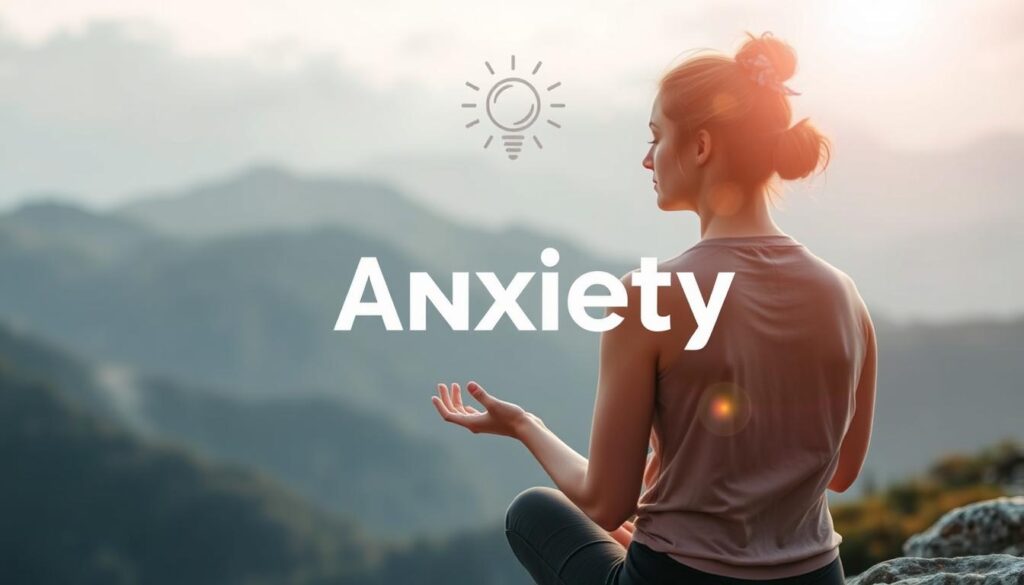I still remember the days when stress and anxiety took over my life. I was constantly thinking about the past or worrying about the future, never truly living in the present moment. That’s when I discovered mindfulness meditation, a simple yet powerful tool that has transformed my life.
Mindfulness is about gently focusing your awareness on the here and now, without judgment. It’s not just about sitting cross-legged on a cushion; it can be incorporated into everyday activities like cooking or walking. By being more present, I’ve experienced numerous benefits, from reduced stress to improved focus.
By integrating mindfulness into daily life, you can expect to see improvements in your mental health, relationships, and overall well-being. It’s a skill that develops with consistent attention and awareness, leading to a more balanced and fulfilling life.
Key Takeaways
- Discover how mindfulness meditation can reduce stress and improve mental health.
- Learn how to incorporate mindfulness into your daily activities.
- Understand the benefits of being present in the moment.
- Explore the connection between mindfulness and improved focus.
- Find out how mindfulness can enhance your overall well-being.
Understanding Mindfulness: The Foundation of Present-Moment Awareness
As we explore the world of mindfulness, we start with its core concept. Mindfulness is the practice of gently focusing ourawarenesson thepresent momentover and over again. This practice is not just about being calm, but about developing a specific quality ofattentionto our present experience.
What Mindfulness Really Means
When we talk about mindfulness, we’re referring to the act of being fully engaged in the present – fully present in the here and now. It’s about paying attention to ourthoughts, feelings, and sensations without judgment. In practical terms, mindfulness means being aware of our experiences as they happen, without getting caught up in them. For instance, when we’re eating, we savor each bite, noticing the flavors, textures, and smells. When we’re walking, we’re aware of the sensation of our feet touching the ground, the movement of our legs, and the rhythm of our breath.
The Difference Between Mindfulness and a “Full Mind”
It’s easy to get confused between being mindful and having a “full mind.” A full mind is cluttered withthoughts, worries, and distractions, whereas being mindful is about being rooted in the present moment. Ourmindis naturally inclined to think, analyze, and figure things out – that’s its job. Left to its own devices, our mind will constantly seek out new stimuli, new things to think about, and new ways to check out from reality. Mindfulness is about changing our relationship with these thoughts, rather than trying to stop them altogether. By being mindful, we can observe our thoughts and feelings without getting caught up in them, allowing us to stay present and focused.
The Science Behind Mindfulness Practice
Let’s explore the intriguing research that has been done onmindfulnessand its effects on our brains, and what it means for our daily lives. As we dive into the science, we’ll discover how regularmindfulness practicecan lead to significant changes in our brain structure and function.
Research-Backed Evidence
Numerousstudieshave been conducted to understand the impact ofmindfulnesson our brains. A 2019 study on first-time meditators who underwent 40 days ofmeditationtraining showed significant changes in brain structure, including gray matter volume and cortical thickness, linked with lower depression scores.
Another study in 2020 on long-term meditation practitioners between the ages of 24 and 77 found significantly lower rates of annual brain tissue loss in meditators, specifically in regions related to mood regulation and emotional processing.
Theseresearch-backed evidences demonstrate the positive impact ofmindfulnesson our brains, showing that it’s not just a practice for relaxation, but it can lead to tangible changes in our brain structure.
How Mindfulness Changes Your Brain
So, how exactly doesmindfulnesschange our brains? The answer lies in the concept ofneuroplasticity– our brain’s ability to rewire itself. Regularmindfulness practicehas been shown to increase gray matter in regions associated with learning, memory, and emotional regulation.
As we practicemindfulness, we are also slowing down the aging process of our brain, protecting our cognitive function as we get older.
Moreover,mindfulnessaffects our stress response by lowering the levels of stress hormones like cortisol, giving us a physiological understanding of why we feel calmer aftermeditation.
These changes bring numerousbenefits, from better emotional regulation to enhanced cognitive abilities, making a strong case for incorporatingmindfulnessinto our daily lives.
Mental Health Benefits of Mindfulness Meditation
As we dive into the mental health benefits of mindfulness meditation, it’s clear that this practice is a powerful tool for improving our overall well-being. Mindfulness meditation has been extensively studied, and the results are compelling. Research has shown that regular mindfulness practice can have a significant impact on our mental health, reducing stress and anxiety while improving our overall sense of well-being.
Reducing Stress and Anxiety
One of the most significant benefits of mindfulness meditation is its ability to reduce stress and anxiety. Studies have shown that regular mindfulness practice can help break the cycle of rumination and catastrophizing, which are common patterns of thinking that can contribute to anxiety. By creating a buffer between triggering events and our emotional reactions, mindfulness meditation gives us more choice in how we respond to stressors. For instance, a 2020 review found that Mindfulness-Based Stress Reduction (MBSR) was effective in treating young people with anxiety symptoms.
Alleviating Depression Symptoms
Mindfulness meditation has also been shown to be beneficial in alleviating depression symptoms. By creating distance from negative thought patterns and increasing awareness of positive experiences, mindfulness practices can help individuals manage their depression more effectively. Research has found that Mindfulness-Based Cognitive Therapy (MBCT) can be as effective as medication for certain mental health conditions, making it a valuable tool in the treatment of depression.
Enhancing Overall Well-being
Beyond reducing stress and anxiety, and alleviating depression symptoms, mindfulness meditation can enhance our overall well-being. By promoting a sense of connection, purpose, and presence, mindfulness practice can help us feel more grounded and more connected to ourselves and others. A 2019 study found that MBSR was effective at increasing well-being, reducing perceived stress, and increasing job satisfaction in the workplace, highlighting the benefits of mindfulness meditation for overall well-being.
Physical Health Advantages of Regular Mindfulness Practice
The connection between our mind and body is intricate, and mindfulness practice can have a profound impact on our overall physical health. As we explore the fascinating mind-body connection, we’ll look at how mindfulness practices can influence physical health outcomes in surprising ways.
Research has shown that mindfulness meditation can activate the body’s relaxation response, reducing inflammation and supporting immune function. According to a 2019 review, mindfulness interventions offered multiple benefits for individuals with cancer, including reducing stress, reducing pain, improving quality of life, and improving immune response more information on mindfulness and health.
Pain Management and Reduction
Mindfulness changes our relationship with physical pain by separating the sensory experience from the emotional suffering that often accompanies it. By using specific mindfulness techniques for managing chronic pain conditions, individuals can reduce pain intensity and improve their quality of life. For instance, body scan meditations help increase awareness of physical sensations and tension, allowing individuals to release stress held in the body.
- Reduce pain intensity
- Improve quality of life
- Increase awareness of physical sensations
Improving Sleep Quality
Mindfulness practices can improve sleep quality by calming the racing thoughts that often keep us awake at night. By practicing mindfulness, individuals can regulate their breathing patterns, reduce stress, and create a more conducive environment for sleep.
- Calming racing thoughts
- Regulating breathing patterns
- Reducing stress
Cognitive Benefits: Sharpen Your Mind Through Mindfulness
When it comes to improving our mental abilities, we often overlook one of the most straightforward methods: mindfulness meditation. As we explore the cognitive benefits of mindfulness, you’ll see how this simple yet powerful practice can enhance your mental clarity and performance.
Mindfulness is essentially a form of attention training. By practicing mindfulness, you can strengthen your ability to focus on what you choose, rather than being at the mercy of distractions. According to the American Psychological Association (APA), mindfulness can improve your working memory, which is crucial for temporarily remembering information essential to your current task.
Enhanced Focus and Concentration
One of the key benefits of mindfulness is its ability to improve your focus and concentration. By regularly practicing mindfulness, you can train your mind to stay focused on the task at hand, reducing the impact of distractions like social media. This enhanced focus can lead to greater productivity and efficiency in your work and daily activities.
Improved Working Memory
As mentioned by the APA, mindfulness can improve your working memory. Improving this area will make you more effective, giving you more cognitive flexibility. You’ll be less reactive, more open to new information, and more capable of shifting your attention between tasks. This improvement can have a significant impact on your ability to learn new skills and make complex decisions.
Greater Cognitive Flexibility
Mindfulness enhances your ability to adapt to changing situations and shift between different mental tasks without getting stuck. This cognitive flexibility is crucial in today’s fast-paced world, where adaptability is key to success. By practicing mindfulness, you can improve your ability to navigate complex situations and make better decisions.
Emotional Intelligence: How Mindfulness Transforms Relationships
By practicing mindfulness, we can significantly improve our emotional intelligence, leading to more harmonious and meaningful relationships. Mindfulness involves paying attention to our thoughts, feelings, and emotions without judgment, allowing us to live more fully in the present moment.
Developing Self-Awareness
Mindfulness helps us develop self-awareness by increasing our understanding of our own emotional patterns and triggers. Regular mindfulness practice enhances our ability to recognize and name subtle emotional states, which is the first step to managing them effectively. This self-awareness is crucial for emotional intelligence, as it allows us to understand our emotions and how they impact our actions.
Cultivating Empathy and Compassion
Mindfulness naturally cultivates empathy by helping us become more attuned to others’ emotional cues. Practices like loving-kindness meditation specifically develop compassion for ourselves and others, transforming how we approach difficult relationships. By being more empathetic and compassionate, we can improve our communication style, reducing conflicts and deepening connections.

Managing Emotional Reactions
Mindfulness creates a crucial pause between emotional stimulus and response, giving us the space to choose how we react rather than being driven by automatic patterns. This improved emotional regulation can dramatically change our communication style, enabling us to stay present during important conversations and listen actively during disagreements.
| Aspect of Emotional Intelligence | Mindfulness Practice | Benefit in Relationships |
|---|---|---|
| Self-Awareness | Meditation, Reflection | Better Understanding of Personal Emotions |
| Empathy | Loving-Kindness Meditation | Increased Compassion Towards Others |
| Emotional Regulation | Mindful Breathing | More Thoughtful Responses in Conflicts |
By enhancing our emotional intelligence through mindfulness, we can recognize unhealthy relationship patterns and make conscious choices to change them, ultimately leading to more fulfilling relationships.
Getting Started: Essential Mindfulness Meditation Techniques

If you’re new to mindfulness, getting started can be as easy as practicing a few simple meditation techniques. In this section, we’ll explore three foundational practices that can help you establish a strong mindfulness practice.
Mindful Breathing Practice
Mindful breathing is a simple yet powerful technique that involves focusing your attention on your breath. Start by becoming aware of the sensation of your breath moving in and out of your nostrils. Feel the rise and fall of your belly and chest as you breathe in and out. Notice how the breath is cool on the inhale and warm on the exhale. As you focus on your breath, you can let go of distracting thoughts and bring your attention to the present moment. Try it: resting your awareness on the breath, whether you’re making the bed, surfing the web, or walking the dog – nearly every moment is an opportunity to become more present.
Body Scan Meditation
The body scan meditation technique involves systematically bringing awareness to different parts of your body, starting from your toes and moving up to the top of your head. As you focus on each area, release any tension or discomfort, allowing yourself to relax further. This practice helps you develop bodily awareness and can be a powerful tool for managing stress and promoting relaxation.
Loving-Kindness Meditation
Loving-kindness meditation is a practice that cultivates positive emotions toward yourself and others. Begin by directing kindness toward yourself, then gradually extend it to others, including those you may have difficulty with. This practice can help create a sense of connection and goodwill, promoting a more compassionate and empathetic attitude toward others.
These three techniques – mindful breathing, body scan, and loving-kindness meditation – complement each other, addressing different aspects of mindfulness, including attention, awareness, and heart qualities. By incorporating these practices into your daily routine, you can establish a strong foundation for your mindfulness journey.
Mindfulness in Daily Life: Beyond Formal Meditation
The practice of mindfulness extends far beyond the meditation cushion, into the very heart of our daily experiences. While formal meditation is a powerful tool for cultivating mindfulness, its true potential is realized when we integrate it into our everyday activities. By doing so, we can turn even the most mundane tasks into opportunities for presence and growth.
Mindfulness can be applied to various aspects of our daily lives, transforming the way we experience and interact with the world around us. Let’s explore some practical ways to bring mindfulness into our daily routines.
Mindful Eating Practices
Mindful eating is about savoring each bite, paying attention to the flavors, textures, and aromas of our food. It’s a simple yet powerful way to turn meals into rich sensory experiences, improving both digestion and satisfaction. By eating slowly and without distraction, we can enjoy our food more fully and develop a healthier relationship with eating.
Mindful Walking and Movement
Mindful walking involves paying attention to the sensation of each step, the movement of our body, and the surroundings. It’s a great way to connect with our environment and cultivate a sense of calm. Even a short walk to the mailbox can become a refreshing mindfulness practice when done with intention and awareness.
Mindful Communication
Mindful communication is about being fully present in our interactions with others. It involves listening attentively, speaking clearly, and being aware of our own emotions and reactions. By bringing mindfulness into our conversations, we can improve our relationships, resolve conflicts more effectively, and communicate more compassionately.
By incorporating mindfulness into our daily activities, we can deepen our practice and make it a more integral part of our lives. Whether it’s through mindful eating, walking, or communication, the key is to be consistent and patient, allowing mindfulness to become a natural part of our daily experience.
Overcoming Common Challenges in Mindfulness Practice
The path to a consistent mindfulness practice is often fraught with challenges, but these can be overcome with the right approach. As we embark on this journey, it’s essential to acknowledge that our brains are wired to operate on autopilot, with an estimated 95% of our behavior running on default neural networks. Mindfulness is about slowing down these processes, making it a counterintuitive practice that requires patience and persistence.

Dealing with a Wandering Mind
One of the most common challenges faced by mindfulness practitioners is dealing with a wandering mind. It’s easy to get frustrated when your mind drifts away from the chosen focus, but it’s crucial to understand that mind-wandering is a normal part of the practice. Rather than a sign of failure, it indicates that you’re actively engaging with your mental processes. Gently acknowledging the distraction and refocusing your attention is key.
Finding Time for Practice
Finding time for mindfulness practice can be daunting, especially for those with busy schedules. However, incorporating mindfulness into daily routines can be achieved through “habit stacking” – attaching mindfulness exercises to existing habits – or through micro-practices that take less than a minute. Even brief moments of mindfulness can be beneficial, making it accessible to even the busiest individuals.
Managing Expectations
Managing expectations is crucial in maintaining a consistent mindfulness practice. It’s easy to fall into the trap of perfectionism, expecting a “good” meditation session. However, every session, regardless of how it feels, is a valuable learning opportunity. By letting go of high expectations and embracing the process, you can cultivate a more positive and resilient mindset.
| Challenge | Strategy | Benefit |
|---|---|---|
| Wandering Mind | Gentle acknowledgment and refocusing | Improved mental clarity |
| Lack of Time | Habit stacking and micro-practices | Increased mindfulness in daily life |
| High Expectations | Embracing the process, not the outcome | Reduced stress and increased self-acceptance |
Mindfulness for Anxiety: Specific Techniques for Stress Reduction

Mindfulness techniques offer a practical approach to managing anxiety and reducing stress in daily life. By focusing on the present moment, you can learn to navigate the challenges of anxiety with greater ease.
Progressive Muscle Relaxation
Progressive Muscle Relaxation (PMR) is a powerful technique that releases physical tension associated with anxiety. To practice PMR, start by lying or sitting down and relaxing your entire body. Take five deep, slow breaths, and then begin tensing and relaxing different muscle groups, starting with your toes.
Grounding Exercises
Grounding exercises use sensory awareness to pull you out of anxious thought spirals and back into the present moment. This can be as simple as focusing on the sensation of your feet on the ground or the sounds around you, helping to calm both body and mind.
Thought Observation Practice
The Thought Observation Practice helps you create distance from anxious thoughts, viewing them as passing mental events rather than reflections of reality. By observing your thoughts without judgment, you can reduce their impact on your anxiety levels.
By incorporating these mindfulness techniques into your daily routine, you can develop a more resilient approach to managing anxiety and promoting overall well-being.
Mindfulness at Work: Bringing Presence to Your Professional Life
We often think that being too busy to practice mindfulness at work is a luxury we cannot afford. However, incorporating mindfulness into our daily work routine can lead to increased productivity, reduced stress, and a more satisfying work experience. By making small changes to our work habits, we can bring mindfulness into our professional lives.
One way to practice mindfulness at work is by making mindful transitions between tasks. Instead of jumping from one task to another without a pause, take a few deep breaths or spend a few seconds focusing on the present moment. This simple practice can help prevent the mental fragmentation that comes from constant context-switching, helping you stay focused and present.
Making Mindful Transitions
When transitioning between tasks, take a moment to pause and focus on your breath. This brief pause can help you stay focused and avoid the mental fatigue caused by constant task-switching.
Brief Mindfulness Breaks
Incorporating brief mindfulness breaks throughout the workday can also be beneficial. Even in busy or open office environments, you can take a few deep breaths, notice your surroundings, or simply focus on your body. These short breaks can help reduce stress and improve your overall well-being.
For example, you can use a simple table like this to plan your mindfulness breaks:
| Time | Activity | Duration |
|---|---|---|
| 10:00 AM | Deep Breathing | 5 minutes |
| 12:00 PM | Short Walk | 10 minutes |
| 2:00 PM | Body Scan | 5 minutes |
Mindful Listening and Communication
Mindful listening can dramatically improve your interactions with colleagues. When engaging with others, make an effort to truly hear what they are saying, rather than planning your response. This practice can lead to better understanding, reduced misunderstandings, and more effective communication.
As we incorporate mindfulness into our work lives, we can use the image
Creating a Sustainable Mindfulness Routine
A well-crafted mindfulness routine can be the foundation upon which you build a more resilient and focused you. To achieve this, it’s essential to approach mindfulness as a long-term practice rather than a short-term fix.
Setting Realistic Goals
Setting achievable goals is crucial for maintaining a consistent mindfulness practice. Start by identifying a realistic time slot each day that you can dedicate to mindfulness, whether it’s during your morning coffee, lunch break, or before bed. Make it a habit by adding it to your daily to-do list.
Creating a Dedicated Practice Space
Designating a specific space for mindfulness can significantly enhance your practice. It doesn’t have to be a large area; even a small corner in your home can serve as a mindfulness sanctuary. The key is to associate this space with your mindfulness routine, making it easier to get into the right mindset.
Tracking Your Progress
Monitoring your progress is vital for maintaining motivation. Instead of relying on simplistic metrics, observe the subtle changes in your awareness and reactions to challenging situations. This approach will help you appreciate the depth of your mindfulness journey and encourage you to continue.
Resources to Deepen Your Mindfulness Practice
As you continue on your mindfulness journey, you’ll likely want to explore additional resources to support and deepen your practice. With the right tools and guidance, you can enhance your mindfulness meditation and integrate its benefits into your daily life.

Recommended Apps and Online Programs
There are numerous mindfulness apps and online programs available, catering to different needs and preferences. Some popular options include guided meditation apps like Headspace and Calm, which offer structured programs for stress reduction and improved focus. Headspace provides personalized meditation sessions based on your goals and progress, while Calm offers a wide range of relaxing content, including sleep stories and music.
Books on Mindfulness Meditation
For those who prefer a more traditional approach, books on mindfulness meditation can be a valuable resource. Titles like “The Miracle of Mindfulness” by Thich Nhat Hanh and “Wherever You Go, There You Are” by Jon Kabat-Zinn offer insights and practical advice for cultivating mindfulness in daily life. These books range from beginner guides to more advanced explorations of mindfulness practices.
Finding Mindfulness Communities and Teachers
Connecting with mindfulness communities and working with experienced teachers can significantly enhance your practice. Local meditation groups, online forums, and retreat centers provide opportunities to learn from others and share your experiences. The Center for Mindfulness offers online courses and resources, while UMass Memorial Medical Center provides an 8-week live online MBSR course. You can also find certified Transcendental Meditation teachers through their directory.
Embracing a Mindful Life: The Journey Beyond the Practice
As we delve into the practice of mindfulness, we discover that it is ajourneythat permeates every aspect of ourlifeand influences how we experience theworldaround us.
As we continue on this journey, mindfulness gradually shifts from being a formalpracticeto becoming an integratedwayof living. The qualities we cultivate through mindfulness – presence, compassion, awareness, and equanimity – naturally extend beyond meditation sessions into our everyday interactions.
We can see how mindfulness can transform our relationship with life’s inevitable challenges, helping us respond with greater wisdom and less reactivity. For more insights on how to embrace mindfulness, you can read about ithere.
By adopting a mindful perspective, we can deepen our appreciation for ordinary moments, bringing a sense of wonder and gratitude to experiences we might otherwise overlook.
Mindfulness can also help us align our daily choices with our deeper values, helping us live with greater authenticity and purpose. As we continue on thisjourney, we find that ourexperienceof being human is subtly but profoundly changed.
As we embrace amindful life, we realize that it’s not about reaching a destination of perfect awareness, but rather about continuing to begin again with curiosity and compassion, moment by moment.
FAQ
What is the best way to start a meditation habit?
Start small – begin with short, daily sessions, and gradually increase the duration as you become more comfortable with the breathing exercises and the sensation in your body.
How can I reduce stress and anxiety using meditation?
Regular meditation helps calm your mind and body, reducing stress and anxiety by promoting awareness of your thoughts and emotions, and teaching you to manage them more effectively.
Can meditation really improve my focus and concentration?
Yes, meditation has been shown to improve attention and cognitive functioning by training your brain to stay present and focused on the present moment.
How does meditation affect my brain and body?
Meditation can lead to changes in brain structure and function, particularly in areas related to emotional regulation, and can also have a positive impact on physical health, such as lowering blood pressure and improving sleep quality.
Can I incorporate meditation into my busy daily routine?
Absolutely – even a few minutes of meditation each day can be beneficial, and you can incorporate it into your daily activities, such as right before a meeting or during your lunch break.
How can I stay motivated to continue my meditation habit?
Setting realistic goals and tracking your progress can help, as well as finding a meditation community or mindful activities that you enjoy and that keep you engaged.
What are some common challenges people face when starting a meditation habit?
Many people struggle with a wandering mind or difficulty finding the time to meditate, but these challenges can be overcome with patience, persistence, and the right guidance.
Can meditation help with emotional regulation and well-being?
Yes, meditation can help you develop greater self-awareness and improve your ability to manage your emotions, leading to enhanced overall well-being.
